Two economic capital cities in West Africa have embarked on remarkable physical development initiatives aimed at supporting their rapid growth.
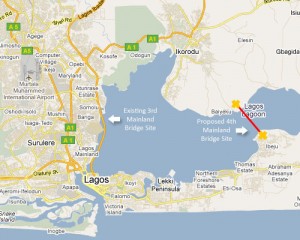
Traversed by water bodies, Lagos in Nigeria and Abidjan in the Ivory Coast are experiencing an escalation in population density as well as vehicular movement between metropolitan settlements separated by the sea.
While the Ebrie Lagoon divides the residential Riviera district and the commercial hub of Marcory, the Lagos Lagoon separates the largely uptown Mainland from the business oriented Island.
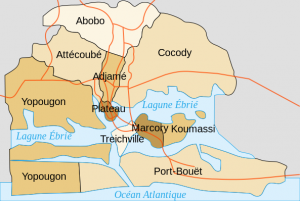
Over the years, overpasses have been built to bridge the respective divides and boost the development of the urban centres. While Abidjan has two existing bridges to serve this purpose, Lagos displays three.
Built between 1954 and 1957, the Felix Houphouët-Boigny Bridge is a road and rail bridge. The second is the Charles de Gaulle Bridge that was built in 1967.
The first of the three bridges connecting the Lagos Island to the Lagos Mainland is the Carter Bridge. Built in 1901, it was constructed by the British colonial government, prior to the Nigerian independence in 1960. After independence, the bridge was dismantled, redesigned and rebuilt during the late 1970s. The Alaka-Ijora Flyover, on the Iddo end of the span, was completed in 1973.
This was followed by the Eko Bridge, which is the shortest of three bridges connecting the Island to the Mainland. It starts from Ijora on the Mainland and ends at the Apongbon area of the Island. The bridge and its landward extension of 1,350 metres were constructed in phases between 1965 and 1975. It serves as the preferred access point for vehicular traffic approaching Lagos Island from the Apapa and Surulere areas of Lagos.
In the bid to further ease the increasing stress resulting from commuters’ accessing the Island from the Mainland, the Federal Government embarked on the ambitious Third Mainland Bridge, which turned out to be not just the longest of the three bridges connecting the Island to the Mainland, but in fact the longest bridge in Africa.
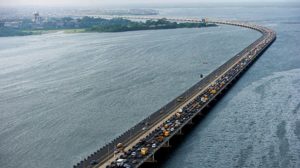
The 11.8km long structure takes off from Oworonshoki which is linked to the Apapa-Oshodi Expressway and Lagos-Ibadan Expressway, and ends at the Adeniji Adele Interchange on Lagos Island. There is also a link midway through the bridge that leads to the Herbert Macaulay Way, Yaba. Built by Julius Berger Nigeria Plc, the bridge was opened by President Ibrahim Babangida in 1990.
However, the bridges are increasingly becoming inadequate as both cities prosper. With over 200,000 vehicles crossing the Felix Houphouët-Boigny and Charles de Gaulle bridges daily, Ivorian authorities believe that it is no longer realistic to have two bridges serving the city; hence the need for a third.
Similarly, Lagos is seeking solace in what looks an unprecedented forth overpass in the overcrowded city, where officials of the Lagos State Government have commenced preliminary work on the Fourth Mainland Bridge, a 26-kilometre infrastructure designed to link Ikorodu to the state’s economic hub in Eti-Osa Local Government Area.
Estimated to gulp a whopping N160 billion, the bridge will provide access from the hinterland to Victoria Island, which is expected to reduce traffic on the ever-busy Third Mainland Bridge and other bridges linking the Mainland to the Island.
From illustrations released by government, the bridge (tagged “The People’s Bridge”) will feature two levels – the upper one for vehicular movement and the lower for pedestrian movement that incorporates a daily market facility.
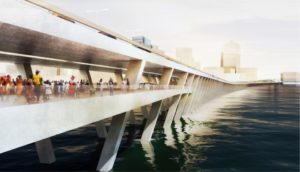
While restating its commitment to the project, the government recently unveiled three different alignment options for the bridge, which officials disclosed was necessitated following the dilemma of having to demolish about 318 houses to accommodate the bridge with the initial alignment.
In Abidjan, the Africa Finance Corporation (AFC) is partnering with the African Development Bank (AfDB) and the Ivorian government to invest N52.65 billion (270 million euro) in financing the Henri Konan Bedie (HKB) Bridge, which will on completion this year be the third bridge in the city.
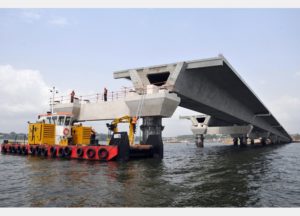
With only two bridges crossing the Ébrié Lagoon around which Abidjan is built, traffic in the centre of the city is often gridlocked.
However, the new toll bridge is expected to reduce transportation time and costs by easing congestion over the existing two (non-tolled) bridges crossing the lagoon within the city.
Key project sponsor – Bouygues Group of France – is building the bridge under a turnkey fixed price arrangement, while the Government of Ivory Coast is providing a 30-year concession with a strong support.
The 1.5km bridge, linked to a new six-lane motorway, will be the first major infrastructure project completed in the city since the 2002 to 2004 civil war dragged the country into a decade of turmoil. It could add 1 percentage point to economic growth, it was gathered.
The toll for using the HKB Bridge could be between 700 (N241) and 1,000 CFA francs (N345).
The bridge is expected to cut the time required to cross the lagoon from Riviera to Marcory, from two hours to about three minutes, boosting economic activity by reducing time lost in traffic.
Ivory Coast’s roughly $40 billion economy makes up nearly half of the gross regional product of West Africa’s eight-nation CFA franc currency bloc.
